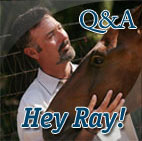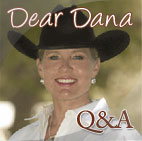Collection: Developing lightness

42nd in a series
Last issue, Les outlined the importance of a soft neck and poll in collection. Here, he gives insight on what to look for.
Collection: Soft neck and poll required

41st in a series
After defining collection and our objectives in working towards it, Les offers pointers this issue as the work gets under way.
Without a soft neck and poll, collection is impossible, so if you still have any resistance in the neck during any of the exercises that we’ve done so far, go back and work on them.
Ready for anything: Collection

40th in a series
After last issue’s look at alignment, Les begins detailed instruction on collection.
Objectives
– To concentrate on driving your horse from the back with your legs, in order to create a soft, round frame.
– To continue to integrate the concept of 50 percent hands/50 percent legs into your riding.
– To learn how to handle a tough or belligerent horse.
– To learn about the elevator bit and how it can help you in your training program.
Straightness check: Maintain alignment

39th in a series
After getting tips last issue on handling our horse’s attentiveness, Les now gives us some “straightforward” hints.
Start at a walk in a straight line. Make sure your hands are evenly spaced out in front of you and that your legs are relaxed. As you move along, I want you to concentrate on feeling what the horse is doing rather than watching for problems.
If you feel the horse start to bow or lean in either direction, use your hands and legs to get him straight again. If it helps, fix your eyes on something in the distance and make sure he stays moving straight toward it.
Dealing with a Distracted Horse

38th in a series
This issue, Les points out that patience and discernment are keys when your horse’s attention veers.
Sometimes when you’re riding you’re going to lose your horse’s attention. I say don’t make a big deal out of it. Some might not see as well as others, or may be more spooky, especially as far as young horses go, when they go off to the Bahamas every now and then; leave it alone and it goes away. Be patient.
Backing: Rein cue to leg cue

37th in a series
After looking at hip control last issue, Les reviews with us some pointers on backing up.
Exercise 4: Hip control on the fence

36th in a series
After looking with Les at Body Control exercise on the fence last issue, we look at a new exercise involving hip control.
Exercise 3: Body control on the fence

35th in a series
Last issue, Les presented a pair of exercises aimed at ribcage and hip control on the fence. This week we continue with awareness of lead-changing with the back leg first.
Exercise number three is basically sidepassing, but it will have one big difference for most of you. While most novice riders start sidepassing by moving the shoulders and catching up with the hips, I’m not going to let you do it that way.
Ribcage and Hip Control on the fence

34th in a series
Last issue, Les provided new exercises to develop lateral movement. Here are some more!
Total body control is the foundation of all maneuvers both in your reined work and on cattle. Hip control is critical in departures and lead changes, because you need to make sure your horse steps off with the correct hind leg in order to get the correct lead. Also in turnarounds and speed transitions, keeping the hip in place stabilizes the whole maneuver. Learning to maintain the correct alignment for each maneuver is critical for stopping, turnarounds and circles in particular, but plays a part in everything you will do.
New exercises: Lateral movement

33rd in a series
Last issue, Les reviewed the “reverse arc” and the nature of right- and left-footed horses. We move now deeper into lateral movement with some new exercises.
Objective
– To start teaching your horse to let you move his whole body laterally
– To start teaching your horse to let you move his hip
– To learn to do both of these things without letting the shoulder lead the movement
– To improve your back-up or overcome resistance if you’re having problems
– To learn to feel whether your horse is straight from head to tail and learn how to correct him if he is not
– To learn how to back your horse easily and softly



 Read Columns
Read Columns

